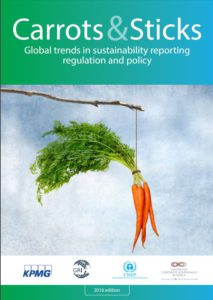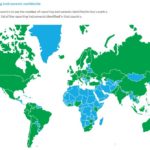
Today the new trend report about Sustainability Reporting Instruments has been published. Last year, 2015, was a milestone for sustainability with crucial and unprecedented agreements by the international community, including the Sustainable Development Goals (SDGs) and the Paris Agreement on climate change action. The year 2016 now calls for translating these achievements into action to achieve the 2030 Agenda for Sustainable Development. It also marks the tenth anniversary since the first Carrots & Sticks report was published in 2006. (The second report was published in 20104 and the third in 2013).
Carrots & Sticks is produced jointly by KPMG International, GRI, United Nations Environment Programme (UNEP) and The Centre for Corporate Governance in Africa (at the University of Stellenbosch Business School). Objective of this report: an assessment of progress in sustainability reporting instruments In this report we assess developments in sustainability reporting instruments worldwide since the publication of the last Carrots & Sticks report in 2013. By ‘reporting instruments’ we mean any instrument, mandatory or voluntary, that requires or encourages organizations to report on their sustainability performance.
Key findings
• There has been a surge in the number of reporting instruments identified since the last report in 2013. Our 2016 research identified almost 400 sustainability reporting instruments in 64 countries versus 180 instruments identified in 44 countries in our 2013 report. The growth of reporting instruments in Europe, Asia Pacific and Latin America has been particularly strong
• Government regulation accounts for the largest proportion of sustainability reporting instruments worldwide with governments in over 80 percent of the countries studied in this research introducing some form of regulatory sustainability reporting instrument
• Mandatory instruments dominate but growth in voluntary instruments is also strong. Around two thirds of the instruments we identified are mandatory and around one third voluntary. Around one in ten instruments adopts a ‘comply or explain’ approach • The level of activity of stock exchanges and financial market regulators is noteworthy in the 2016 edition of this report, with these two groups together responsible for almost one third of all sustainability reporting instruments identified
• Almost one third of reporting instruments apply exclusively to large listed companies and of these around three quarters have been introduced by financial market regulators and stock exchanges. The remaining two thirds apply either to all companies or to other types of companies such as state-owned
• While most reporting instruments cover all sectors (crosssectoral scope), those that target specific sectors address the finance and heavy industry sectors in particular. The number of reporting instruments for companies in the financial services sector has more than doubled from 2013 to 2016 and they now account for almost 40 percent of sector specific instruments
• Governments and regulators increasingly require or encourage companies to disclose sustainability information in their annual reports
• There has been a large increase in instruments driving reporting of social information. The number of instruments we identified that focus on reporting of social information has almost doubled since 2013, growing faster than instruments that focus on the reporting of environmental information
• Regulation on tax disclosure has increased as companies come under increasing pressure to demonstrate they pay their fair share of taxes in all countries in which they operate
Download the full report (pdf)



